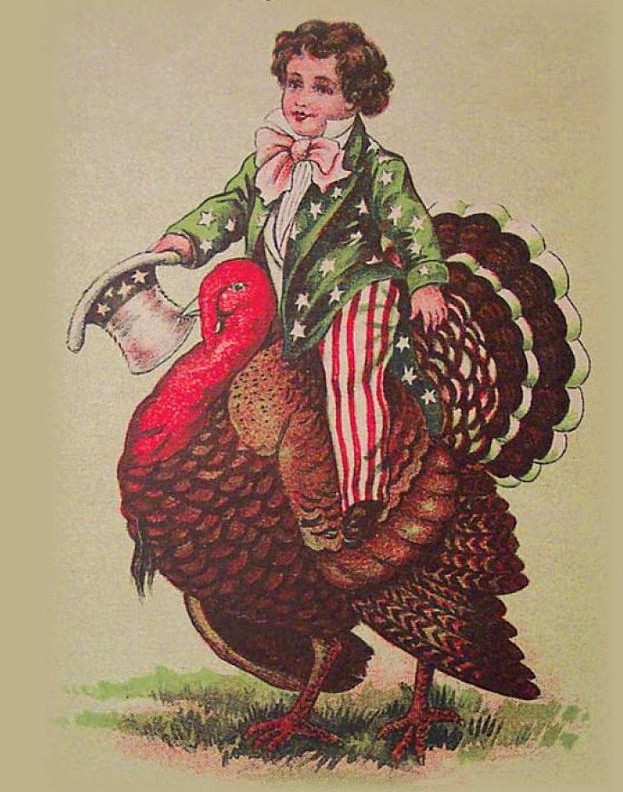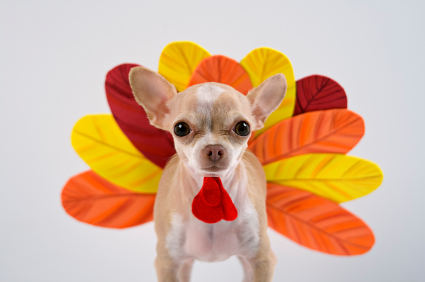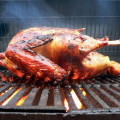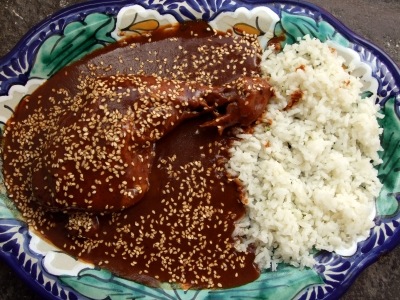Collected by Dave DeWitt
Note: Most hundred-year-old (or more) descriptions of Thanksgiving are insufferably sappy, but thanks to the hard-working scanners at Google Books, I was able to cobble (or gobble) together some suggestions for making this holiday a little more interesting than usual.
How about a shooting match with live targets?
A Perfect Thanksgiving Diversion, 1897
Another of the sportive features of the Yankee Thanksgiving Day, now almost extinct, was the shooting-match, usually held in the morning, and therefore not viewed with favor by the Church, because of its tendency to entice the youth from the Thanksgiving service. In an open field a base-line was marked on the turf. From this were laid off certain shooting-distances. Eight rods, about, was chicken distance; about nine rods, turkey distance; while for rifle-shooting, with a turkey as target and prize, the distance was more arbitrary, but not often more than twenty rods. [A rod is 5.5 yards]
Or some cross-dressing? [Har, har]
Have a Halloweeny Thanksgiving, 1897
Another and somewhat strange way of observing the holiday in New York has been, up to very recent years, to dress one’s self in the most fantastic costume imaginable and parade the streets. Hundreds of companies of these motley persons, under some such name as the “Square Back Rangers,” the “Slenderfoot Army,” or the “Original Hounds,” and dressed chiefly, as an old account says, as “clowns, Yankees, Irishmen, kings, washerwomen, and courtiers,” thronged the streets all day. Thousands and thousands of small boys who put on their sisters’ old dresses, smeared paint on their faces, pulled on red, yellow, brown, black, and indiscriminate wigs, and pranced round their own particular streets, without the least fear of police interference.”
Both from: Curiosities of Popular Customs and of Rites, Ceremonies, Observances, and Miscellaneous Antiquities, by William Shepard Walsh. Philadelphia: J.B. Lippincott Co., 1897.
And serve this nice boiled double turkey, the ancestor of the turducken…
A Weird Thanksgiving Turkey, 1894
Boned Turkey
We will have another way of stuffing a boned turkey besides the annexed, but this, to use the words of a delighted club member, just recently, “takes the cheese”—whatever that may mean. The gentleman is a Britisher having millions in mines, (can’t get ’em out), but, thanks to the error of French cookery he had never stuck his fork before into so unmistakably genuine a galantine as this.
2 turkeys.
1 corned tongue, already cooked.
1 pound of dry salt pork.
8 hard-boiled eggs.
1 cupful of aspic jelly.
Seasonings.
Take a large and a small turkey unopened, singe and wash and then bone them, cutting first down the whole length of the back. When boned lay them skin downwards on the table and season with pepper and salt, or with spiced salt. Cut the cooked red tongue and the fat unsmoked bacon into strips pencil size and lay them alternating on the turkey meat, lengthwise of the fowl, cutting gashes in the thickest parts to receive them evenly. Cut the yolks of the eggs in quarters and dispose them evenly among the strips, then chop the jelly and strew it over.
Roll, or rather double up carefully the smaller turkey and place it inside the other, remembering to turn it so that there will be found when the galantine is cut a breast at each end. Bring the two edges of the outside turkey together and sew it up with cotton twine and a large needle. Butter a cloth and roll the galantine up in it tightly and with a good many wraps, and either tie or sew it securely. Boil in soup stock with the turkey bones added.
From: The American Pastry Cook, Vol. 1, by Jessup Whitehead. Chicago: J. Whitehead & Co., 1894.
Okay, okay, just barbecue one in your living room…but eviscerate it first…
Spit-Roasted Turkey in the Fireplace, 1872
In season from December to February. Time, according to size, from one hour and fifteen minutes to two hours, or two hours and a half. Half a pint of forcemeat for veal, or sausage meat; a little butter.
To truss the bird: pick the bird carefully, and singe off the down with a piece of lighted white paper; break the leg bones close to the feet; hang it on a hook and draw out the strings from the thigh; cut the neck off close to the back, but leave the crop skin long enough to turn over the back; remove the crop, and with the middle finger loosen the liver and gut at the throat end. Cut off the vent, remove the gut, take a crooked wire and pull out the gizzard, and the liver will easily follow. Be very careful not to break the gall bladder; if you do it will spoil the flavor of the bird entirely, by giving it a bitter taste, which no after efforts of washing, etc., can remove. Do not break the gut joining the gizzard either, lest the inside should become gritty. Wipe the inside perfectly clean with a wet cloth, then cut the breast bone through on each side close to the back, and draw the legs close to the crop. Put a cloth on the breast, and beat the breast-bone down with a rolling-pin till it lies flat. Scald the feet, peel off the outer skin, and cut away the claws; leave the legs on.
Fill the inside with veal stuffing or sausage meat, and either sew the skin of the neck over the back with a trussing needle, or fasten it with a very small skewer. Then run a long skewer into the pinion and thigh through the body, passing it through the opposite pinion and thigh. On the other side, put a skewer in the small part of the leg and push it through. Clean the liver and gizzard and tuck them between the pinions, and turn the point of the pinions on the back. Pass a string over the points of the skewers, and tie it securely at the back to keep the bird neat and firmly trussed. Cover the breast with a sheet of nicely buttered white paper.
Place the bird on a spit or roasting jack, and set it at some distance from the fire, which should be a very good and bright one. Keep the heat well to the breast. Put a quarter of a pound of butter in the dripping-pan, and baste it frequently, to prevent it drying too much. Just before it is finished dressing, remove the paper, dredge it lightly with flour, and baste it with the butter, so as to brown and froth it. Serve it with good brown gravy poured over it, and garnish with small fried sausages or forcemeat ball.
From: The Cuisine: Containing Household Cooking Recipes Prepared Under the Supervision of an Eminent Caterer, by D. D. Foster. Boston: Fox & Company, 1872.
Oh, just FYI…
Your Thanksgiving turkey was 32 per cent bones and other refuse, and 45 per cent water, leaving only 23 per cent of nutrients. This makes the nutritive portion of your turkey cost 87 cents per pound—if you paid 20 cents [per pound for it].
From: Annual Report of the Secretary of the Board of Agriculture. Massachusetts State Board of Agriculture. Boston: Wright & Potter Printing Co., 1896.









